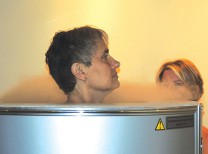It’s starting to get warmer again, and James and his wife have been active enjoying the outdoors. Over the past few weeks, they have been playing pickleball, swimming laps in their pool and taking walks. Life is great, but he has noticed increasing pain in his right shoulder and doesn’t know what to do. James came to my office to see what could help so he could continue these activities he loves. He is a right-handed 56-year-old male from Palm Desert. With his permission, here’s a summary of what we discussed that will serve as an example of a common sports injury diagnosis.
Medical history. James’ medical history, including medications, surgeries and allergies, is noncontributory. Overall, he’s a pretty healthy guy – except that his right shoulder has been killing him for the past two months. Nothing specific, like a fall or traumatic injury, happened to trigger the pain. He points to the outer front side of his shoulder, where he tells me the pain is about 7 out of 10. The pain is localized and isn’t radiating down his arm or up his neck. He is experiencing sharp pain whenever he lifts his arm up over his head and tells me that he sometimes notices some clicking or popping. Besides that, there are no other associated symptoms. The pain is worse when he is playing pickleball or swimming, and it is better with rest, ice and occasional Advil. He has not previously seen a doctor nor had any radiological imaging.
The diagnosis. Based on his presentation, confirmed by a physical exam, James has subacromial bursitis, also known as bursitis of the shoulder. This condition is typically determined by a clinical diagnosis and does not require imaging.
Body mechanics. I explain to James the condition and treatment. Throughout our body, we have many bursae, which are fluid-filled sacs that act as cushions. We have them in our knees, hips, and elbows, to name a few. These bursae are integral in preventing friction during movement and protecting our bones and surrounding tissues. Our shoulder has one of the largest bursae due to the size and frequent use of the joint. This specific bursa is located in the subacromial space, which refers to the area right below the bony part of our shoulder. When a subacromial bursa gets inflamed, it is known as subacromial bursitis and can be very painful. Subacromial bursitis is often a result of overuse, so it is likely the repetitive overhead movement of his recreational activities that is causing his pain.
Treatment and prevention recommendations. Initial treatment options include rest, activity modification, ice, anti-inflammatory medications (oral and topical) and physical therapy. I let James know that, for now, he should rest and can return to his sports once his range of motion increases and he starts feeling less pain during those movements. With his active lifestyle, I highly recommend that he take some time to warm up and stretch before any activity, especially those involving his shoulders.
He can also perform exercises at home to build up strength in the surrounding muscles, or he can switch to alternative workouts that don’t include repeated overhead movement. If he continues to feel pain, we can discuss other options, including imaging, injections or alternative care, to reestablish function.
James is not alone in this diagnosis, as bursitis is a very common condition. If you are experiencing similar symptoms, be sure to see your health care provider to discuss your individual case and treatment plan.
Founding physician Eric Sickinger, DO and medical assistant Thalie Timsit, BS are with Advanced Center for Sports & Musculoskeletal Medicine. For more information, contact their Palm Desert office at (760) 636.1067 or the San Clemente office at (949) 388.1060, or visit www.SportsandMSKmedicine.com.









































Comments (0)